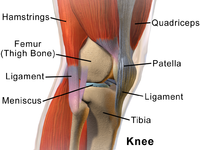
Photo from wikipedia
Osteoarthritis (OA) remains the most challenging arthritic disorder, with a high burden of disease and no available disease-modifying treatments. Symptomatic early-stage OA of the knee (the focus of this Review)… Click to show full abstract
Osteoarthritis (OA) remains the most challenging arthritic disorder, with a high burden of disease and no available disease-modifying treatments. Symptomatic early-stage OA of the knee (the focus of this Review) urgently needs to be identified and defined, as efficient early-stage case finding and diagnosis in primary care would enable health-care providers to proactively and substantially reduce the burden of disease through proper management including structured education, exercise and weight management (when needed) and addressing lifestyle-related risk factors for disease progression. Efforts to define patient populations with symptomatic early-stage knee OA on the basis of validated classification criteria are ongoing. Such criteria, as well as the identification of molecular and imaging biomarkers of disease risk and/or progression, would enable well-designed clinical studies, facilitate interventional trials, and aid the discovery and validation of cellular and molecular targets for novel therapies. Treatment strategies, relevant outcomes and ethical issues also need to be considered in the context of the cost-effective management of symptomatic early-stage knee OA. To move forwards, a multidisciplinary and sustained international effort involving all major stakeholders is required. In this Review, the authors assess the current understanding of symptomatic early-stage knee osteoarthritis, including its diagnosis and classification, and highlight important gaps in knowledge that will need to be addressed to enable effective management. Early-stage knee osteoarthritis (OA) could present a ‘window of opportunity’ in which to arrest the disease process at the early stages and restore joint homeostasis. The initiating cellular and molecular cascade of events in early disease need to be studied in more detail and connected to triggering events and the patient profile. The goal of classification criteria for early-stage knee OA is to enable discrimination of patient populations with early-stage symptomatic knee OA, who are at increased risk of structural progression, from patients with knee symptoms due to other reasons. Final classification criteria for early-stage knee OA should be validated by a multidisciplinary panel of experts in the field with involvement of all relevant stakeholders. Early diagnosis in clinical practice enables proper disease management and reduction of the burden of disease. Early-stage knee osteoarthritis (OA) could present a ‘window of opportunity’ in which to arrest the disease process at the early stages and restore joint homeostasis. The initiating cellular and molecular cascade of events in early disease need to be studied in more detail and connected to triggering events and the patient profile. The goal of classification criteria for early-stage knee OA is to enable discrimination of patient populations with early-stage symptomatic knee OA, who are at increased risk of structural progression, from patients with knee symptoms due to other reasons. Final classification criteria for early-stage knee OA should be validated by a multidisciplinary panel of experts in the field with involvement of all relevant stakeholders. Early diagnosis in clinical practice enables proper disease management and reduction of the burden of disease.
Journal Title: Nature Reviews Rheumatology
Year Published: 2021
Link to full text (if available)
Share on Social Media: Sign Up to like & get
recommendations!